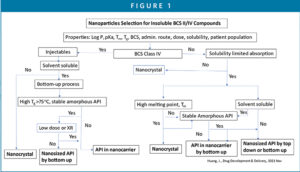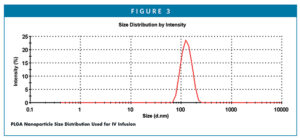Issue:November/December 2021
FORMULATION FORUM - Amorphous Nanoparticles for Drug Delivery of Poorly Water-Soluble Compounds
INTRODUCTION
A pharmaceutical amorphous nanoparticle is a solid particle, wherein amorphous drug is nanosized and surrounded by stabilizer(s) or is dispersed in a nanosized carrier at a molecular level. Amorphous nanoparticles are relatively a new class of pharmaceutical dosage forms, possessing the advantages of both nanoparticles and amorphous materials in enhancing solubility and bioavailability of insoluble drugs. Nanosizing offers the advantages of enhancing the rate of drug release by increasing surface area for dissolution, whereas amorphous formation could significantly increase the solubility of poorly soluble drugs in aqueous medium. The saturated solubility and dissolution rate of amorphous nanoparticles could potentially be increased by more than thousand-folds relative to its crystalline counterpart. As a result, the GI absorption and bioavailability of orally administered drugs could be significantly enhanced, particularly for poorly water-soluble drugs classified as BCS IIa and IIb. BCS II compound possess drug biopharmaceutical properties with high GI permeability and low water solubility, which is subdivided into BCS IIa (dissolution limited absorption) and BCS IIb (solubility limited absorption).
The advantages of amorphous nanoparticles include improving solubility and bioavailability, suitable for injectable dosage forms, eliminating food effect, increasing drug loading, eliminating co-solvents, dose reduction, better dose flexibility and accuracy, and easy swallowing for pediatric or geriatric populations.
RATIONAL DESIGN OF AMORPHOUS NANOPARTICLE DOSAGE FORMS
Despite the aforementioned advantages of amorphous nanoparticles, intrinsic solid state metastability of amorphous materials and colloid nature of nanosuspension dosage forms warrant a rational design of amorphous nanoparticles dosage forms in order to extend their application from discovery to clinical testing and ultimately to commercial application. A good understanding of compound properties (Tg, Tm, log P, PKa, solubility, permeability, stability), solvent solubility, miscibility/compatibility with carrier/stabilizer, therapeutic dose in relevant to drug loading, route of administration, and patient population, etc, will help define the target product profile and design a stable dosage form with enhanced drug solubility and bioavailability.
A good candidate for amorphous nanosuspension has the characteristics of BCS Class II and IV compounds: low solubility, amorphous form with a high Tg, a requirement for injectable with high drug loading/solubility ratio, oral dosage form with low bioavailability, and a strong tendency of food effects. A decision guide to decide the suitable form of the nanosuspension and selection of process technology are outlined (Figure 1).
SELECTION OF FORMULATION PRINCIPLE
Based on solid state properties of the API, there are two options for amorphous nanoparticles: 1) nanosized amorphous drug surrounded by stabilizer(s); 2) API dispersed in a nanosized carrier at a molecular level. If the amorphous API can be reproducibly manufactured, and it possesses characteristics that could maintain its physical-chemical properties during process, storage, and in-vivo physiological conditions, eg, a high transition point, (Tg-Tstorage>50°C), strong glass former, non-hygroscopicity, and ability to maintain supersaturation in GI fluid within the transition time period without recrystallization, it is possible that amorphous APIs can be nanosized by traditional top-down milling process with the help of polymers and surfactants as the stabilizers. Top-down technology involves the disintegration of larger particles into nanoparticles, examples of which are being used in Ascendia Pharma include high-pressure homogenization, micro-fluidization, sonication, and wet milling methods, etc.
If an API forms a fragile glass, which has a Tg of <75°C, and readily recrystallizes out during storage or in-vivo dissolution, it is often necessary to utilize excipients to form a multiple-component amorphous system (ie, amorphous solid dispersion) to stabilize and inhibit the amorphous drug from crystallization at its solid or aqueous states. An amorphous nanoparticle with a carrier such as polymer, lipid, surfactant, or others will be needed to disperse API at a molecular level in the matrix to stabilize the amorphous API; a bottom-up process could be selected to facilitate the dispersion of drug in the carrier and formation of amorphous nanoparticles, wherein API is molecularly dispersed. Bottom-up technology is an assembling method to form nanoparticles by dissolving the AI in a solvent and then undergoing a solvent removal process, examples of which are being used by Ascendia Pharma include precipitation, co-precipitation, or nano-emulsification methods.
FORMULATION & PROCESS DEVELOPMENT
For nanosized amorphous drug nanoparticles prepared by the top-down process, formulation and process development are similar to crystalline nanosuspension as outlined in a previous Formulation Forum.1 A formulation screening study is conducted under a miniature scale to find the suitable stabilizer(s), ie, a polymer, a surfactant, or a combination of polymer/surfactant for the nanosuspension. Different surface properties of API, such as surface charge, hydrophobicity, functional groups responsible for ionic, hydrogen bond, and Van der Waal interactions, may demand different types and levels of stabilizers. The performance of nanosuspensions should be confirmed by in-vitro studies such as stability, re-dispersibility, and in-vivo performance in animal models.
For amorphous nanoparticles in which drug is dispersed in a nanosized carrier at a molecular level, the initial screening studies to select carrier and stabilizer is similar to that of amorphous solid dispersions as outlined in a previous Formulation Forum.2 The primary goals of a screening study are to find a polymer and/or surfactant that is physically miscible and chemical compatible with drug, can load reasonable amount of drug in nanoparticle matrix, and to enhance solubility and stability of insoluble compound in-vitro and in-vivo. Matrix-type amorphous nanoparticles can be prepared using a bottom-up process, high-shear mixing, high-pressure homogenization, or combination of a bottom-up process with a bottom-down nanosizing process. Drug is dissolved in organic solvent(s) together with other stabilizer excipients, which are induced to precipitate by introduction of non-solvent(s). Variation of formulation and process parameters can generate amorphous drug nanoparticles of different particle size that can be further incorporated into dosage forms by a downstream process.
PROCESS FOR AMORPHOUS NANOPARTICLES
Antisolvent Precipitation/ Co-Precipitation Method
Antisolvent precipitation/coprecipitation method is one of the commonly used bottom-up techniques to prepare amorphous nanoparticles. This method involves dissolving of API and stabilizer(s) in a common solvent, induction of nanoprecipitation by mixing the solvent solution containing API/polymer with an antisolvent, removal of solvent by evaporation or ultrafiltration, and optionally nanosizing using a high shear/pressure/ultrasonic/extrusion process. Different parameters, such as mixing speed, solvent/nonsolvent ratio, drug to stabilizer ratio, drug and stabilizer concentration, and mixing temperature, etc, can be optimized to generate amorphous nanoparticles with a desired particle size distribution and stability profile. Rapid mixing of solvent solution with nonsolvent creates a supersaturation condition that generates precipitation of API as amorphous nanoparticles with or without a carrier. This method is suitable for compounds that are solvent soluble, poorly water soluble, hydrophobic, form stable amorphous forms, or have a high glass transition point.
Nano-Emulsification Method
Nano-emulsification is the process by dispersing one liquid phase into another immiscible liquid phase that generates a uniform mixture of nanodroplets. In the pharma industry, these two immiscible liquids typically consist of an organic (oil/solvent) phase and an aqueous (water) phase in the presence of stabilizer such as surfactant, co-surfactant, and polymer (W/O emulsification). Traditionally, nano-emulsification has been achieved by high shear homogenization, microfluidization, and ultrasonication for nanocapsulation of amorphous hydrophobic compounds, followed by solvent evaporation process if solvent is used. In a modified way, amorphous nanoparticles of hydrophilic drug can be manufactured by a W/O/W emulsification process followed by high pressure homogenization and solvent evaporation process.
Wet Milling Technology
Wet milling (top-down process) is a milling technique commonly used for nanocrystal suspension preparation. It can be also used to wet mill amorphous APIs into nanoparticles if the amorphous drug has enough stability during the process and storage. Another application of wet milling technology used to generate amorphous nanoparticles is by a combination of wet milling with a bottom-up antisolvent precipitation process.
High Pressure/High Shear Technology
Similar to wet milling technology, high pressure homogenization or microfluidization can also achieve nanosuspensions with narrow particle size distribution as a top -down process. Alternatively, a combination of bottom-up and top- down process, ie, solvent dissolution of API, precipitation by non-solvent, and then homogenization of freshly formed particles, could be utilized.
Ultrasonication
Ultrasonication (>20 kHz) is a process of applying sound energy to agitate particles in a liquid. Ultrasonication creates cavitation that improves mixing and mass transfer locally at the contact surface. Ultrasonication can be conducted using an ultrasonic bath or an ultrasonic probe. Ultrasonication could be used in both the top-down (reducing suspension particle size) and bottom-up method (to control particle size and crystallinity at time of solvent/nonsolvent mixing) for preparation of nanoparticles. Depending on API intrinsic solid state properties, ultrasonic energy intensity, ultrasonic exposure time, mixing mode (on line mixing or post mixing of solvent to nonsolvent), solvent/nonsolvent ratio, type, and level of stabilizer, etc, the ultrasonic process may generate crystalline or amorphous nanoparticles with varied particle size distribution.
A CASE STUDY-PLGA NANOPARTICLES FOR IV INFUSION
A compound was classified as BCS IV (low solubility, low permeability). The compound was targeted for IV infusion due to low oral bioavailability. Because it has a narrow therapeutics index, a sustained-release nanoparticle formulation was desired to enable IV infusion, to reduce Cmax, and to increase half-life for the purpose to reduce compound toxicity and to increase drug exposure at the target organ. Based on the assessment of the compound properties, Ascendia’s Nanosol® Technology was utilized for screening and in-vitro assessment of the nanoparticle sustained-release formulation. An O/W nano-emulsification was explored using biodegradable PLGA polymers as the nanocarrier for the compound. Several nanosuspension prototype formulations with in-vitro release rate ranging from <1 day to >2 weeks were developed and tested for stability and animal PK. The particle size of the lead nanoparticles was determined to be ~100-200 nm (Figure 3). The lead prototype nanosuspensions achieved a corresponding in-vivo long half-life up to 1 day to 2 weeks that decreases the drug toxicity and increases drug exposure at the target organ site in animal models.
SUMMARY
Amorphous nanoparticles are a new class of pharmaceutical dosage forms, which have been increasingly used in pharmaceutical compounds with solubility and bioavailability enhancement at discovery, preclinical, and early clinical development phases. Thorough understanding of their amorphous stabilization and nano colloidal properties in relationship to in-vitro and in-vivo performance will help advance this interesting dosage form into human clinical testing and commercialization.
REFERENCES
- Jim Huang, Drug Development & Delivery, June 3, 2020, FORMULATION FORUM – Rational Design of Oral Nanosuspensions for Insoluble Drugs; https://drug-dev.com/formulation-forum-rational-design-of-oral-nanosuspensions-for-insoluble-drugs/.
- Jim Huang, Drug Development and Delivery, June 4, 2019, FORMULATION FORUM – Amorphous Formulations for Insoluble Drugs: Rational Design & Practical Approaches on Formulation Screening & Development; https://drug-dev.com/formulation-forum-amorphous-formulations-for-insoluble-drugs-rational-design-practical-approaches-on-formulation-screening-development/.
To view this issue and all back issues online, please visit www.drug-dev.com.

Jim Huang, PhD
Founder & CEO
Ascendia Pharmaceuticals
j.huang@ascendiapharma.com
www.ascendiapharma.com
Total Page Views: 6381













